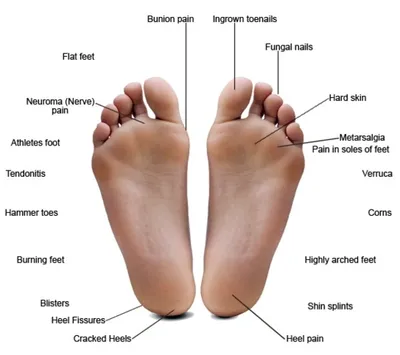Taking care of your feet is as vital as caring for any other part of your body. They support your weight, keep you mobile, and allow you to explore the world. Despite their importance, foot problems are frequently ignored until they cause severe discomfort or disrupt daily life. This guide dives into common foot issues and shares practical tips to keep your feet in top shape.
Understanding the Importance of Foot Health
Why Foot Health Matters
Your feet are the foundation of your body. They support your weight and help maintain balance and mobility. Ignoring foot health can lead to pain, limited mobility, and even long-term health issues, such as back problems. Many people only focus on foot care when they face issues, but proactive care can significantly enhance your quality of life.

The Anatomy of the Foot
The foot is a complex structure made up of 26 bones, 33 joints, and over 100 muscles, tendons, and ligaments. This intricate network works together to help you stand, walk, run, and perform countless movements daily. Understanding how your foot functions can help you recognize early signs of trouble and take preventative measures.
Most Common Foot Problems
Bunions
Bunions are bony bumps that develop at the base of the big toe. They form when the big toe pushes against the next toe, causing the joint to enlarge and stick out.
- Causes: Wearing tight, narrow shoes is the most common culprit. Genetics and arthritis can also contribute.
- Symptoms: Swelling, redness, and pain around the big toe joint. In severe cases, the misalignment may hinder movement.
- Risks: If untreated, bunions can worsen, leading to joint damage and chronic pain.


Plantar Fasciitis
Plantar fasciitis is one of the leading causes of heel pain. It occurs when the thick band of tissue connecting your heel to your toes (plantar fascia) becomes inflamed.
- Key Symptoms: Stabbing pain in the heel, particularly in the morning or after prolonged periods of rest.
- Aggravating Factors: High-impact activities, poor arch support, and excessive standing can exacerbate the condition.
Athlete’s Foot
This is a fungal infection that commonly affects the toes. It thrives in warm, moist environments, making locker rooms and damp socks breeding grounds for fungi.
- How it Spreads: Sharing towels, shoes, or walking barefoot in communal areas can lead to infection.
- Complications: If left untreated, it can spread to the nails or other body parts, causing persistent itching and discomfort.


Corns and Calluses
Both are thickened skin areas, but corns are smaller and often occur on non-weight-bearing parts of the foot, while calluses develop on pressure points.
- Causes: Ill-fitting shoes, repetitive movements, or excessive friction can lead to these skin formations.
- Possible Discomfort: While they are generally harmless, they can cause pain if they press against nerves or worsen over time.
Ingrown Toenails
An ingrown toenail occurs when the edge of the toenail grows into the surrounding skin, causing pain, swelling, and sometimes infection.
- Common Triggers: Cutting nails too short or improperly, wearing tight shoes, or sustaining a foot injury.
- Risks of Ignoring: If untreated, infections can spread, leading to more severe complications.

Causes and Risk Factors of Foot Problems

Poor Footwear Choices
Shoes that are too tight, have high heels, or lack proper support can lead to foot deformities, blisters, and long-term pain. Footwear plays a pivotal role in preventing problems like bunions, corns, and plantar fasciitis.
Lack of Hygiene
Skipping regular cleaning or failing to dry feet thoroughly after washing can lead to fungal infections and unpleasant odors. Dirty feet are a breeding ground for bacteria and fungi.
Genetic Predisposition
Some people inherit structural abnormalities, like flat feet or high arches, making them more prone to issues like bunions or plantar fasciitis.
Repeated Stress or Overuse
Athletes and individuals with physically demanding jobs often subject their feet to repeated stress. Over time, this can cause injuries like stress fractures or plantar fasciitis.
Prevention Tips for Healthy Feet

Choosing Proper Footwear
Features of Good Shoes
Wearing the right shoes is the cornerstone of maintaining healthy feet. Proper shoes should offer:
- Adequate Arch Support: Prevents strain on the arches and reduces conditions like plantar fasciitis.
- Breathable Material: Keeps your feet dry, reducing the risk of fungal infections.
- Cushioned Soles: Absorbs shock, minimizing the impact on joints.
- Proper Fit: Shoes that are too tight or too loose can lead to bunions, corns, and blisters.
Importance of Orthotics
Orthotic insoles can provide customized support, addressing specific foot issues like flat feet or overpronation. They are especially helpful for individuals who stand for extended periods or engage in high-impact activities. Custom orthotics, though pricier, offer the best results.
Maintaining Foot Hygiene
Best Practices
Clean and dry feet are less prone to infections. Follow these tips for proper hygiene:
- Wash your feet daily with mild soap and warm water.
- Thoroughly dry between toes to prevent fungal growth.
- Use a pumice stone to remove dead skin and avoid calluses.
Products for Hygiene Maintenance
Investing in products like antimicrobial foot sprays, exfoliating scrubs, and moisturizers can keep feet healthy and odor-free. Antifungal powders are also effective for preventing athlete’s foot in sweaty or damp conditions.
Regular Exercise for Foot Strength
Exercises to Strengthen Feet
Strengthening your feet can prevent injuries and improve balance. Examples include:
- Toe Stretching: Pull toes apart gently to relax the muscles.
- Calf Raises: Strengthens the arch and improves circulation.
- Rolling Exercises: Use a tennis ball to massage the sole of the foot.
Benefits for Overall Mobility
Strong feet provide better balance, reduce the risk of falls, and support your overall posture. These exercises also prevent stiffness, particularly in aging populations.
Keeping Weight Under Control
Impact of Weight on Feet
Excess weight puts undue pressure on your feet, leading to conditions like plantar fasciitis, arthritis, and heel pain. Weight-related issues can also affect your gait, causing long-term damage to joints and ligaments.
Strategies for Weight Management
- Maintain a balanced diet rich in nutrients to support bone health.
- Incorporate low-impact exercises like swimming and cycling to reduce foot stress.
- Monitor your BMI and consult a dietitian if necessary.
When to See a Specialist
Persistent Pain or Swelling
Pain or swelling that doesn’t subside with rest or over-the-counter treatments signals a deeper issue. Specialists like podiatrists can diagnose underlying conditions, such as stress fractures or infections.
Visible Changes to the Foot
Changes like discolored toenails, lumps, or deformities should never be ignored. These could be signs of conditions like fungal infections, bunions, or even skin cancer.
Difficulty Walking or Standing
If walking becomes painful or standing for long periods feels unbearable, seek professional help. Chronic discomfort often indicates conditions like nerve damage or severe plantar fasciitis.
Treatments for Common Foot Problems

Over-the-Counter Solutions
Many minor foot issues can be managed with OTC products like:
- Anti-inflammatory medications for pain relief.
- Silicone pads to cushion corns and calluses.
- Antifungal creams for infections like athlete’s foot.
Physical Therapy and Exercises
Physical therapy can target specific issues, such as restoring flexibility after plantar fasciitis or strengthening muscles weakened by bunions. Tailored exercises can often prevent the need for invasive procedures.
Medical Procedures for Severe Issues
When conservative treatments fail, medical intervention may be necessary. Examples include:
- Bunion Surgery: Corrects bone misalignment.
- Corticosteroid Injections: Reduces inflammation in conditions like plantar fasciitis.
- Ingrown Toenail Removal: Prevents recurring infections.
Lifestyle Tips for Long-Term Foot Health

Importance of Regular Check-ups
Routine visits to a podiatrist can catch issues early. Regular foot check-ups are especially important for individuals with diabetes, who are prone to infections and ulcers.
Daily Practices for Happy Feet
- Moisturize daily to prevent cracks and dryness.
- Wear breathable socks to reduce sweat and odor.
- Avoid prolonged periods of standing without breaks.
Stress Relief Techniques for Feet
After a long day, give your feet some TLC:
- Soak them in warm water with Epsom salts.
- Use a foot roller to relieve tension.
- Elevate your feet to reduce swelling and improve circulation.
Conclusion
Your feet are integral to your overall health. By choosing proper footwear, maintaining hygiene, and staying active, you can avoid many common problems.
Don’t wait until pain strikes—proactively caring for your feet ensures mobility and comfort for years to come. Remember, happy feet mean a happier you!
Frequently Asked Questions
What are the most common signs of foot problems?
Persistent pain, swelling, discoloration, or difficulty walking are common warning signs.
How often should I replace my shoes to prevent foot issues?
Replace shoes every 6-12 months or sooner if they show signs of wear, especially in the soles and cushioning.
Are home remedies effective for treating foot pain?
Simple remedies like ice packs, stretching, and foot soaks can help, but consult a professional for persistent pain.
How can I prevent foot odor caused by sweating?
Wash your feet daily, dry them thoroughly, and use antifungal powders or sprays. Wearing moisture-wicking socks also helps.
Is walking barefoot good or bad for foot health?
Walking barefoot can strengthen foot muscles, but it may increase the risk of injury or infection, especially on hard or dirty surfaces.
What can I do to relieve foot pain after a long day?
Soaking your feet in warm water, using a foot massage roller, or elevating your feet can help reduce pain and swelling after a long day.











Goodd post. I leaqrn somethng totally new and challenging on sites I
stumbleupon everyday. It’s lways iinteresting to read thhrough artickes from other authors annd usee somethng fdom thir sites.